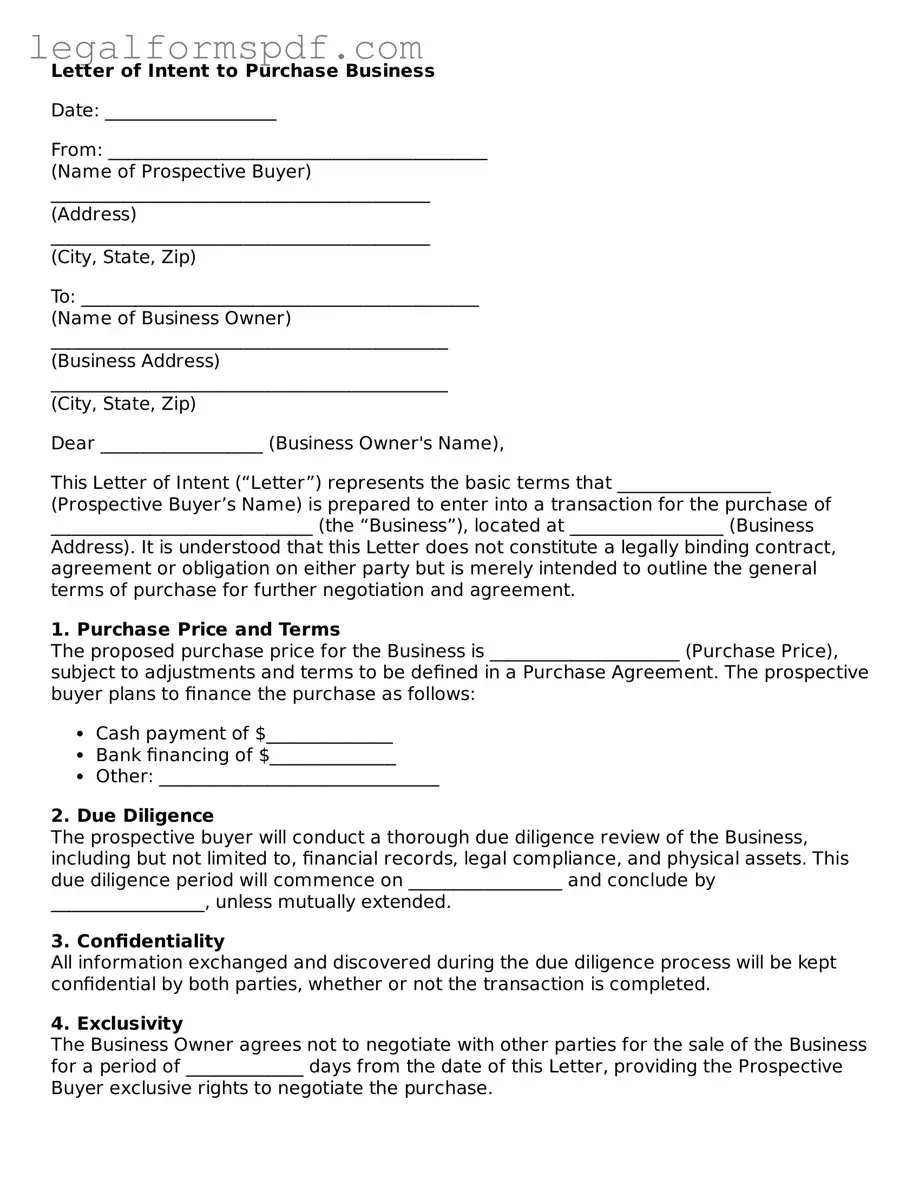What is a Letter of Intent to Purchase Business?
A Letter of Intent to Purchase Business is a document used by a prospective buyer to express their intention to buy a particular business. This letter outlines the basic terms of the purchase agreement, including price, terms of payment, and any conditions that must be met before the final purchase. Though not legally binding in terms of the sale itself, it sets the stage for formal negotiations and due diligence before finalizing the transaction.
When should I use a Letter of Intent to Purchase Business?
This letter should be used when you have identified a business that you are seriously interested in buying and wish to enter into formal discussions with the seller. It is a preliminary step that allows both parties to agree on the main terms before investing time and resources into the due diligence and legal processes required to complete the sale.
Is a Letter of Intent legally binding?
Generally, a Letter of Intent itself is not legally binding in terms of obligating either party to complete the sale. However, certain provisions within it, such as confidentiality agreements and exclusivity arrangements, can be binding. It's important to clearly specify which parts of the letter are intended to be binding.
What key elements should be included in a Letter of Intent to Purchase Business?
Key elements include the proposed purchase price, payment terms, due diligence requirements, any conditions precedent to completing the transaction, confidentiality clauses, and an exclusivity period during which the seller cannot entertain offers from other prospective buyers. Additionally, the letter should outline the expected timeline for negotiation, due diligence, and closing the transaction.
How does a Letter of Intent differ from a Purchase Agreement?
A Letter of Intent is a preliminary document that outlines the basic terms and intentions of both parties to engage in a transaction. It is not a definitive agreement but rather a roadmap to negotiation. A Purchase Agreement, on the other hand, is a detailed and legally binding contract that finalizes the terms of the sale, including all obligations, representations, warranties, and conditions of the sale.
Can I back out of a Letter of Intent to Purchase Business?
Since a Letter of Intent is generally not legally binding regarding the sale's completion, parties can typically back out without legal consequences. However, if the letter contains binding provisions, such as confidentiality agreements, those aspects must still be honored. It's crucial to understand what you're agreeing to before signing a Letter of Intent.
What happens after a Letter of Intent is signed?
After signing, the buyer typically begins the due diligence process to verify the business's financials, operations, legal standing, and other critical aspects. Both parties might also start negotiating the final Purchase Agreement based on the terms outlined in the Letter of Intent. This phase continues until either a Purchase Agreement is signed, or either party decides not to proceed with the transaction.
Do I need a lawyer to draft or review a Letter of Intent to Purchase Business?
While not strictly necessary, it's highly advisable to have a lawyer experienced in business transactions review or draft your Letter of Intent. This step ensures that the letter accurately reflects your intentions, protects your interests with proper legal language, and includes necessary binding provisions like confidentiality clauses.
Are there any risks associated with using a Letter of Intent to Purchase Business?
Yes, there are potential risks. For example, if not properly drafted, the Letter of Intent could unintentionally bind you to certain terms or conditions, limiting your ability to negotiate or back out of the transaction. Additionally, the exclusivity period could prevent you from exploring other potentially better opportunities. Thus, it's crucial to approach the Letter of Intent process with clear intentions and, ideally, legal counsel.
